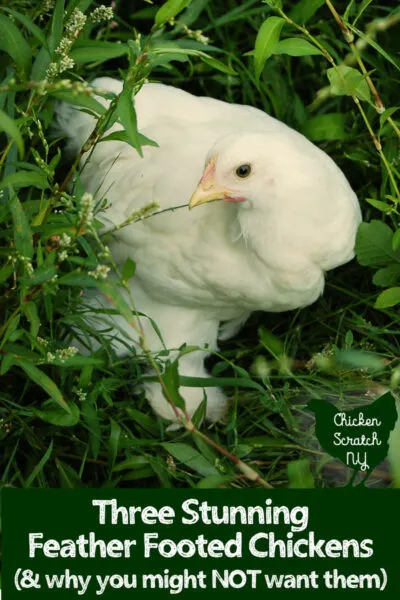Big chickens can add a lot to your life, here are 3 of the largest chicken breeds you can keep for eggs, meat or as pets!

I love big chickens, my favorite breed has always been the Brahma and a big part of that is their size. But to tell the truth, I’ve never met a giant chicken I didn’t love.
As with everything, they can have some issues but I think those are more than outweighed by the benefits.
Benefits of Large Breed Chickens
Most of this is based on my personal experience with chickens. I’ve been raising my own birds for over a decade and since I favor chaos I’ve always had a large mixed flock.
All of my favorite chickens have been large-breed birds. A big part of that is their personality.
Larger chickens tend to be much calmer, I think the larger size makes them less scared and as a result, they have chill personalities.
That’s not to say they’re always calm, I’ve seen a Brahma rooster body check a hawk. That large size also seems to come with a side of self-confidence!
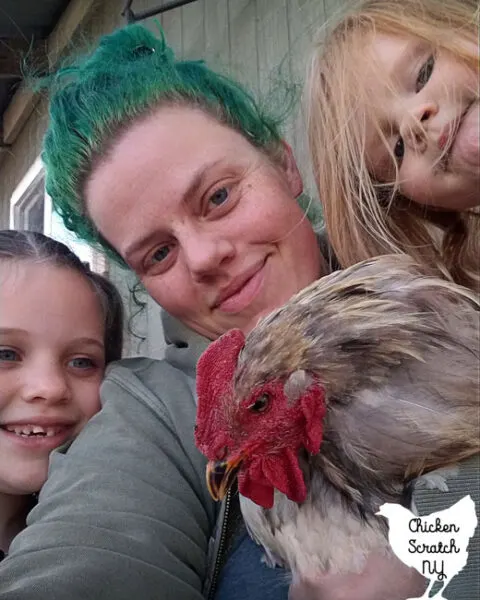
Over the years I’ve had a lot of roosters, easily over 100, and I’ve never had a mean large breed rooster. My kids named our giant Cochin ‘Super Fluffy’ because when he was younger he would defend them from the tiny a-hole bantam rooster that hated the world.
We still have Super Fluffy, he’s getting old and he’s been very spoiled. He waits by the back door for snacks every day and occasionally spends the night in the garage to give him a break from the younger roosters.
Along with being more docile, I’ve found my big birds stay closer to home. They know where the food is and they aren’t interested in missing a meal.
They are less active than something like an Appenzeller Spitzhauben that considers a marathon a quick warm-up. This makes them a great choice if you need to pen up your birds.
Read more about Appenzeller Spitzhauben, the Best Crested Breed
Obviously, they still need space but they’re going to be happier in a coop with a run than a really active bird that wants to bop all over the place.
Another benefit to that big size is with predators. I don’t think it’s a coincidence that my longest-lived birds have been Brahmas.
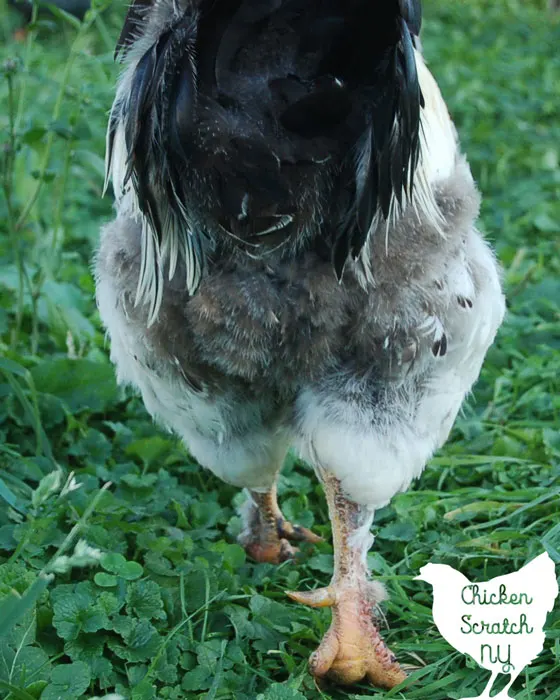
The biggest predator issue I have is with hawks, they’ll pick off young birds and even adult bantams but a full-grown Brahma hen weighs between 8 and 10 pounds and most hawks aren’t going to mess with that.
Read more about Bantam Chickens
The fact they stay close to the barn even though they have free range over the entire property keeps them safer from foxes who like to lurk in the safety of the neighbor’s fields and pick up wandering chickens.
I’ve got one more benefit to add to the list but it’s geographically based and depending on where you live this might be an issue for you. Large chickens do better in cold winters.
They have more body mass to help maintain their body heat. Just about all of the best winter-laying breeds are what I would consider large.
If you live in a really hot area you’re probably going to want more slender, less heavily feathered birds with large combs.
But if you’re dealing with snow and freezing cold winters? Get yourself a big chicken with a little comb!
Problems with Big Chickens
There are two sides to every coin, and of course, that’s also true when it comes to raising big chickens.
When it comes to feeding time, large chickens are going to eat more and go through feed faster than their daintier counterparts. It’s just like needing to feed a Golden Retriever more than a Chihuahua.

It won’t matter that much if you’ve only got a handful of chickens but if you’re looking to save money and produce a lot of eggs, this is not the direction you want to be going in.
If maximum production is your goal, stay away from any dual-purpose breed. Look for something like Leghorn or hybrid layers like Sexlinks or Golden Comets.
Learn more about Hybrid Layers & Sexlink Chickens
There is also the matter of housing, big chickens are going to need more room per bird when it comes to the coop, run and roost size than smaller birds. Not because they’re more active (spoiler, they aren’t) but just because they physically take up more room.
For a large breed hen plan for 12 inches of roost per bird, compared to 8-10 inches for a smaller hen. When it’s colder you’ll notice the chickens really pack themselves together but when it’s hot out they’ll want extra space.
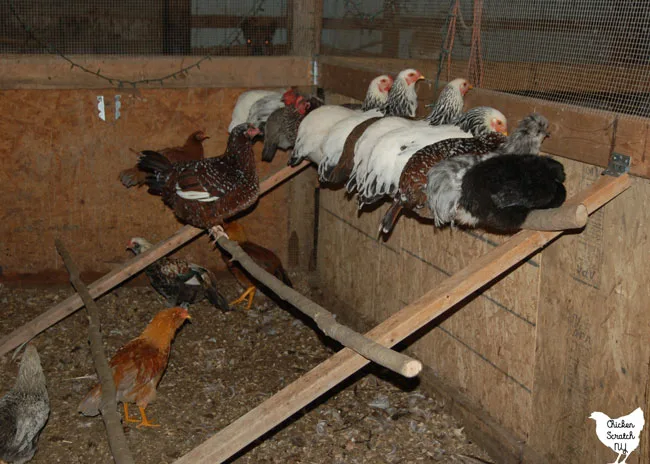
You might even notice them standing on the roosts with their wings spread to help them cool down, something that isn’t possible if they’re packed like sardines.
Larger birds are much happier to roost close to the ground. I have really high 6+ foot high roosts and another set that only gets about 4 feet off the ground and my big girls and boys are almost always on the shorter roosts.
As far as coop space, a large hen should have 8 square feet per bird while a smaller hen should be given 4 square feet.
Of course, those are just guidelines, most space is always a good thing (unless it’s super cold, then your birds will benefit from a smaller coop that they can keep warm with body heat).

If you’re working with a small prebuilt coop you’re going to want to stick to the low end of the occupancy recommendation or go even lower.
When you’re figuring out all of these numbers keep the weather in mind, depending on where you live there may be weeks or even months where your birds are stuck in the coop and you really don’t want them getting overcrowded.
Bored chickens are a recipe for disaster, they’ll find something to entertain themselves and that may very well be beating up a flock mate.
Read more about Keeping Chickens Entertained Indoors
Unfortunately, large chickens aren’t the most efficient layers either. You’ll still get a decent amount of delicious farm-fresh eggs but they aren’t going to win any production awards.
More of the energy they take in from feed goes to keeping the birds going, and less goes into eggs. However, even though they lay less overall than something slender like a Leghorn, they tend to lay all year round even in the coldest months.
When you combine those two, more feed and fewer eggs, it does mean that financially they’re not the best choice. Personally, that’s not really what I’m in this game for so I think the benefits more than make up for the issues.
Another thing to keep is mind is that the chicks grow really quickly but tend to mature more slowly than the smaller breeds and take longer to start laying eggs. So you end up up waiting longer for fewer eggs.
Large Chicken Breeds
All of the birds on this list are considered Dual Purpose breeds. At its most basic that means they are used for both eggs and meat.
I’ve eaten our extra roosters and they made A+ soup but they aren’t going to look like a traditional grocery store chicken. They take a lot longer to reach ‘harvest’ size and they’re going to be overall leaner, have more dark meat, and a stronger flavor.
Read more about Dual Purpose Chickens
Eating a bird you raised from an egg (or that you’ve raised since its grandparents were eggs) isn’t for everyone. It’s not something I do often but it definitely makes you think twice about wasting food once you’ve been face to face with what it takes to get it on the plate.
Brahama
Let’s start out with the best chicken breed on the planet, the Brahma. Some of the first chickens I ever owned were Light Brahmas.

Two of them lived over 9 years before dying peacefully in their sleep, not an ending you often see on a free-range chicken farm!
The most common color variation is the Light Brahma, a mostly white bird with dark feathers on the neck and tail.
You can also find Buff Brahmas, where the white feathers are replaced by a soft reddish tan, and Dark Brahmas, which are some of the prettiest chickens I’ve ever seen in my life.

Dark Brahma feathers have ‘penciled’ patterning which looks like someone drew thin lines on each feather. This is one of the rare varieties of chicken where the hens are much more attractive than the roosters, the boys lack the gorgeous penciling and are pretty basic looking.
Brahma roosters are big boys, most will be around 12 pounds when fully grown. Once you add fluffy feathers to that you’re looking at a hefty man.
The adult hens weigh around 9.5 pounds, which is still pretty impressive. I’ve had a lot of roosters smaller than my Brahma ladies.
In a year you can expect between 180-240 medium-large brown eggs, and that’s during the full year, not just spring and summer! One thing Brahma hens are known for is being good winter layers.
During the course of the year, the colors in my egg cartons shift a lot, during the winter the vast majority of the eggs I collect are the light brown color laid by my Brahmas, Wyandottes, and Cochins.
Brahmas are also known for having very chill and relaxed personalities. They’re curious, and friendly and are a great pick if you have kids.
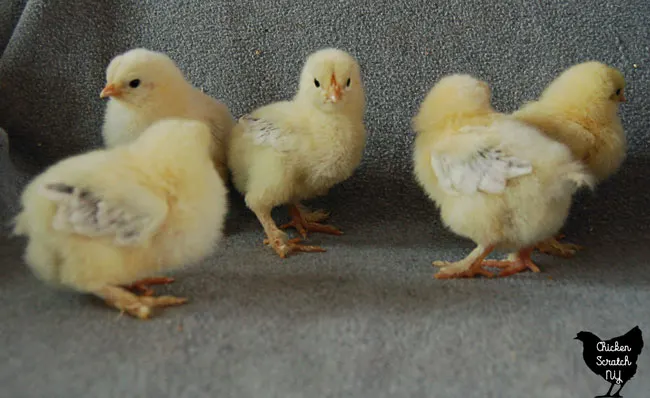
I wouldn’t consider them a super common breed like Rhode Island Reds or Buff Orpingtons but they’re basic enough that they aren’t super expensive. Straight-run chicks will run you $3-4 and sexed female chicks are $4-5.
The chicks are already giants from hatching, between the size and the feathering on their toes they are pretty easy to pick out of a crowd. These little fluffs are light Brahmas and the yellow fluff will be replaced with mostly white feathers.
Cochin
Moving on to another giant breed that I’ve been lucky enough to keep, Cochins! This is another Asiatic breed (like Brahmas) and they’re known for their giant size, having tons of feathers and docile personalities.

The only unkind Cochin I’ve ever met was actually a Bantam cochin rooster, roughly the size and shape of a volleyball and he was full of anger. Try as he might, he never managed to reach higher than mid-calf, and most of the time I didn’t even realize he was trying to main me.
Read more about Bantam Chickens
Going back to the standard-size birds, Cochin roosters weigh in at 11 pounds and the hens are around 8.5 pounds. That makes them about a pound smaller than Brahmas.
But you’d never guess that by looking at them! Cochins have a very loose and puffy look to their feathers compared to the more sleek appearance of Brahmas.

When they’re fresh out of a molt and looking extra fancy Cochins have a very round look. They have fully feathered legs and feet which adds to the appearance of a giant bird.
Cochins aren’t the best layers, you can only expect 110-160 eggs from a hen in a year. Technically they’re more of an ornamental breed (or meat breed) than a laying breed.
The eggs you get will be medium-large and brown. And Cochins are good mamas, they are known for going broody and will hatch anyones eggs.
Read more about Broody Hens
Thanks to their large size and extra feathery fluff they can handle quite a few chicks and keep them toasty warm even when they start getting big.

Cochin chicks are super cute with their fuzzy little bellbottoms. Even as babies, they’re big with a very rounded appearance.
Jersey Giant
Jersey Giants are the biggest hens on this list, they should probably be listest first but I’ve never kept them myself and I wanted to start out with the breeds that I had experience with.
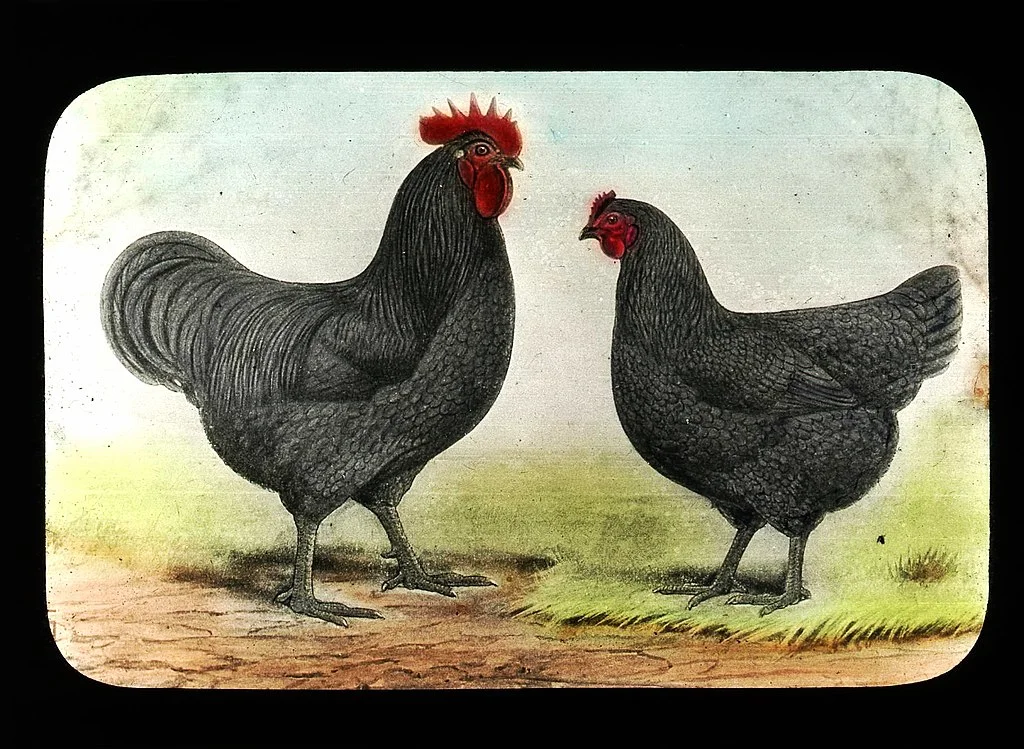
The roosters weigh about 12 pounds but can reach up to 14, putting them on par with the Brahma boys and the hens can reach 10 pounds which makes them about 1/2 a pound bigger than Brahma hens.
The most common coloring is a solid black with a sheen of green iridescence that develops as the birds mature but there is also a white variation. Unlike the other two breeds we talked about, Jersey Giants have clean legs, meaning no feathers.
I love fluffy feathered feet but they can be an issue, especially if you have a lot of mud to deal with.
Read about Feather Footed Chickens & Keeping Mud Off Eggs
Jersey Giants are an American breed, developed in (you guessed it) New Jersey in the 1880s. Despite their size, they aren’t commonly used as meat birds due to their slow growth.
They are decent layers, slightly better than Brahmas with an expected output of 180-260 medium brown eggs per year. They also have calm personalities and a tendency to go broody.
Looking for more information? Check out my Chickens page or start here:


